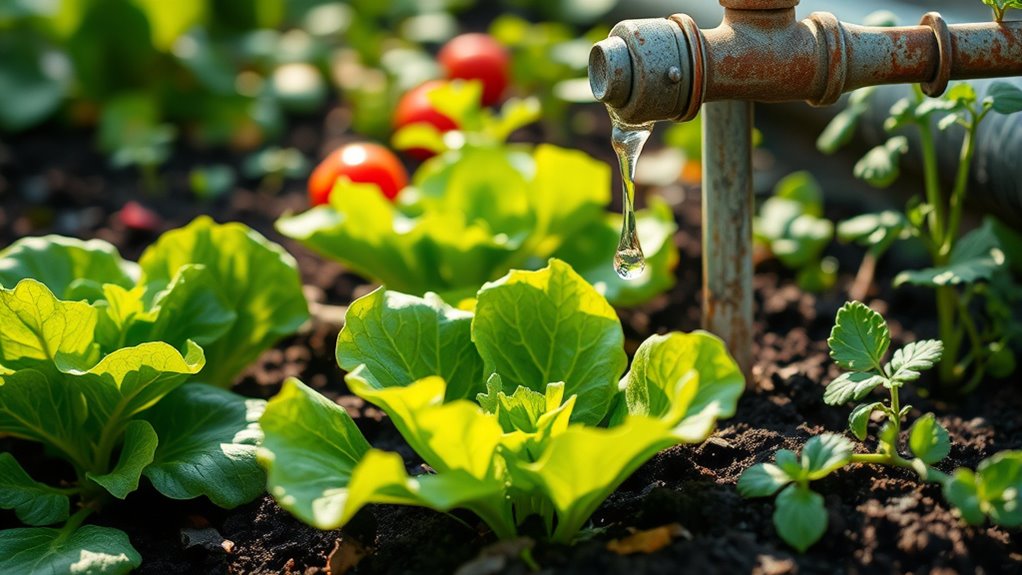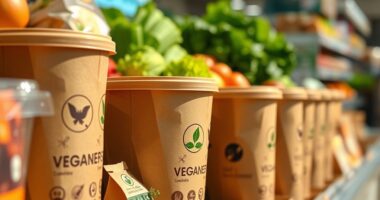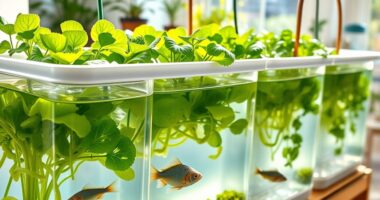Using greywater in your vegetable garden can be safe if you treat it properly to reduce bacteria, soaps, and chemicals. Choose biodegradable, low-sodium soaps and install filtration systems to improve water quality. Avoid direct contact with edible parts of plants, especially fruits and leafy greens, and let greywater sit for a few hours before applying. Proper management minimizes health risks, so if you want to know more, there’s important guidance you should consider.
Key Takeaways
- Proper greywater treatment and filtration are essential to remove contaminants and reduce health risks when watering edible plants.
- Use biodegradable, low-sodium, phosphate-free soaps to minimize chemical residues in greywater.
- Avoid applying greywater directly to edible plant parts; allow it to sit or be treated further before contact.
- Regularly inspect and maintain greywater systems to prevent leaks and contamination risks.
- Use greywater primarily on non-edible landscape plants or root crops, and follow safe watering practices.

Using greywater in your garden can be an effective way to conserve water and nourish your vegetables. However, before you start, it’s essential to understand how greywater treatment impacts veggie garden safety. Greywater, which comes from sinks, showers, and washing machines, contains contaminants that can pose health risks if not managed properly. Proper greywater treatment ensures that harmful bacteria, soaps, and chemicals are reduced or eliminated, making it safer for your plants and family. Without adequate treatment, there’s a risk of transferring pathogens or toxic substances to your edible garden, which is why understanding and implementing proper greywater treatment is vital.
When considering greywater for your garden, safety should be your top priority. You need to be aware of what types of soaps and cleaning products are safe for greywater use. Use biodegradable, low-sodium, and phosphate-free soaps to minimize harmful residues. These products are less likely to harm your soil or plants and reduce the chances of contaminating your vegetables. Also, avoid using greywater containing hazardous chemicals like bleach, disinfectants, or industrial cleaners, as these can persist through treatment processes and pose health risks. Proper greywater treatment involves filtration and sometimes biological treatment systems that remove solids and reduce pollutants. Installing a simple filtration system, such as a gravel and sand bed or a dedicated greywater filter, can considerably improve the safety of your greywater before it reaches your garden.
Another key aspect of veggie garden safety when using greywater is the placement and timing of watering. Keep greywater away from edible parts of plants, especially fruits and leafy greens that come into direct contact with the water. Let greywater sit for a few hours before applying it, allowing some of the contaminants to settle or degrade. Don’t use greywater on root vegetables or crops that are eaten raw unless you’re confident in your greywater treatment process. To further enhance safety, consider watering in the early morning or late afternoon to reduce evaporation and limit the potential for contact with people or animals. Regularly inspect your system to guarantee no leaks or blockages develop, which could lead to contaminated water pooling or spreading. Additionally, using proper greywater treatment methods can significantly reduce health risks and promote safer gardening practices.
Frequently Asked Questions
Can Greywater Be Reused for Organic Vegetable Gardening?
You can reuse greywater for organic vegetable gardening, but you need to take into account greywater contaminants and garden compatibility. Ensure your greywater is free from harsh chemicals and soaps that can harm plants or soil health. Use it on non-root crops and avoid contact with edible parts to minimize risks. Properly managing greywater helps protect your garden’s ecosystem while making the most of this water source.
What Are the Long-Term Health Risks of Using Greywater?
You might wonder about the long-term health risks of greywater use. Think of a hypothetical community that reused greywater for years; over time, they faced increased exposure to long-term toxins like heavy metals and pathogens. These health implications could lead to chronic illnesses. While greywater can be beneficial, you should be aware of potential long-term toxins accumulating in your soil and water supply, posing risks to your health down the line.
How Does Greywater Affect Soil Microbial Life?
Greywater impacts soil microbial life by altering the balance of soil bacteria and affecting microbial diversity. When you use greywater, it introduces nutrients and contaminants that can promote certain bacteria while suppressing others. This shift may reduce overall microbial diversity, which is essential for healthy soil. As a result, your garden’s soil might become less resilient and less capable of supporting robust plant growth over time.
Are There Specific Plants That Tolerate Greywater Best?
Some plants have better tolerance to greywater, especially those like ornamental grasses, certain trees, and hardy perennials. When considering plant tolerance and greywater types, you’ll find that plants with deep roots or those adapted to low-quality water handle greywater more effectively. Avoid using greywater with high detergent levels or containing chemicals, as these can harm sensitive plants. Always test and observe your plants’ response to ensure healthy growth.
What Regulations Exist for Greywater Use in Gardening?
You should know that regulations compliance and safety standards for greywater use in gardening vary by location. Local laws often require permits or specific greywater systems to guarantee safety. It’s essential to check with your municipality or health department to follow proper guidelines. By adhering to these regulations, you reduce health risks and help protect your environment while using greywater effectively in your garden.
Conclusion
So, next time you’re watering your garden, remember that greywater can be both a blessing and a risk. Coincidentally, I recently saw a neighbor’s lush veggies thriving after using greywater—yet just last week, a friend shared concerns about potential toxins. It’s a reminder to stay informed and cautious. With the right precautions, you might just enjoy the greenest, most sustainable garden yet—turning a simple coincidence into a smart, safe choice for your veggies.










